What is DeepSeek & How Does It Work? Benefits & Use Cases
- February 4, 2025
- 21 mins read
- Listen
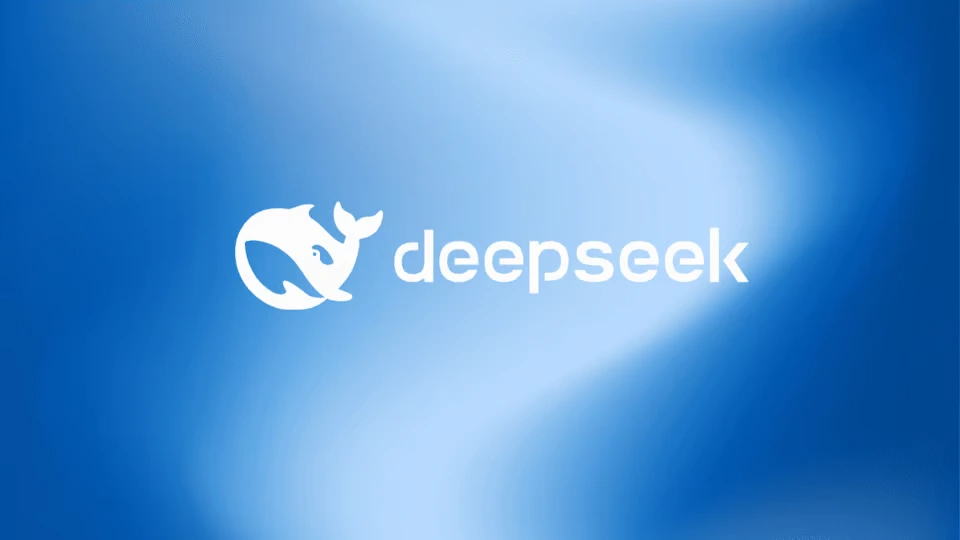
Table of Content
AI is evolving rapidly, and DeepSeek AI is emerging as a strong player in the field. It is an open-source large language model (LLM) designed to understand and generate human-like text, making it ideal for applications like customer support chatbots, content creation, and coding assistance.
What makes DeepSeek stand out? Unlike proprietary AI models, DeepSeek is open-source, meaning businesses and developers can use and customize it freely.
Despite being built with fewer resources than major competitors, it delivers impressive performance through advanced techniques like Multi-head Latent Attention (MLA) for efficiency and Mixture-of-Experts (MoE) for optimized computing power.
In this comprehensive article, we are going to give all the answers you have in your mind about Deepseek. Like what DeepSeek is, how it works, and more.
What is DeepSeek?
Deepseek is an open-source advanced large language model that is designed to handle a wide range of tasks, including natural language processing (NLP), code generation, mathematical reasoning, and more.
In other words, DeepSeek is like a highly intelligent assistant that can understand and work with both human language and computer code.
Its flagship model, DeepSeek-R1, employs a Mixture-of-Experts (MoE) architecture with 671 billion parameters, achieving high efficiency and notable performance.
Benchmark tests indicate that DeepSeek-R1 outperforms models like Llama 3.1 and Qwen 2.5 while matching GPT-4o and Claude 3.5 Sonnet.
Beyond LLMs, DeepSeek has ventured into generative AI with Janus-Pro-7B, a text-to-image model that reportedly outperforms OpenAI’s DALL·E 3 and Stability AI’s Stable Diffusion in image generation.
DeepSeek vs OpenAI & other AI Models
To truly understand what DeepSeek is, it’s helpful to compare it to other popular AI models like ChatGPT, Claude, Gemini, and Qwen Chat. While these models share similarities, DeepSeek stands out in several key areas:
|
Factors |
DeepSeek |
ChatGPT |
Claude |
Gemini |
Qwen Chat |
|
Key Models |
DeepSeek-V3, DeepSeek-R1 |
GPT-3.5, GPT-4, GPT-4-turbo |
Claude 1, Claude 2, Claude 3.5 |
Gemini 1.5, Gemini 2 |
Qwen 2.5 max Qwen 2.5 plus |
|
Open Source Policy |
Open source |
Closed source |
Closed source |
Closed source |
Closed source |
|
Development Cost |
$6M, according to the company |
$500M (estimated) |
$200M (estimated) |
$700M (estimated) |
$300M (estimated) |
|
Best for |
Mathematics, coding, and natural language reasoning |
Excellent conversational abilities and strong general-purpose utility. |
Exceptional at long-form reasoning and extended conversations. |
Strong in creative projects and visual tasks; handles multimedia effectively. |
Multi-lingual expertise (100+ languages); strong enterprise |
|
Architecture |
Hybrid (Mixture of Experts + Dense) |
Dense |
Dense |
Multimodal |
Large-scale dense transformer with multi-modal capabilities |
|
Training Data |
Massive, diverse dataset; regularly updated |
Extensive but less recent (knowledge cutoff date varies by version) |
Focused on long-form reasoning and contextual understanding |
Includes multimodal data (text + visuals) |
Trained on a vast, diverse dataset with a strong emphasis on multi-lingual and cross-domain tasks |
|
Use Cases |
Coding, Creative content writing, Multi-Modal Tasks |
Writing, summarization, answering questions, conversational AI. |
Long conversations, research, detailed explanations, and complex problem-solving. |
Creative projects, visual analysis, multimedia content generation. |
Multi-lingual support, creative writing, coding, Multi-modal tasks. |
|
Scalability |
Highly scalable due to hybrid architecture (MoE + Dense); efficient for large-scale tasks. |
Moderate scalability; dense architecture can be resource-intensive for larger models (e.g., GPT-4). |
Moderate scalability; dense architecture may limit efficiency in resource-constrained environments. |
High scalability for creative and visual tasks; multimodal focus may limit purely textual scalability. |
Highly scalable; optimized for both small-scale and enterprise-level deployments. |
Learn more: DeepSeek vs ChatGpt
Who is Behind DeepSeek?
DeepSeek was founded in 2023 by Liang Wenfeng, a Chinese entrepreneur from Guangdong province. Before launching DeepSeek, he co-founded High-Flyer, a hedge fund that now funds and owns the company.
Under Liang’s leadership, DeepSeek has developed open-source AI models, including DeepSeek-R1, which competes with top AI models like OpenAI’s GPT-4 but with lower costs and better efficiency.
Liang’s work has gained recognition in the tech industry, and in January 2025, he was invited to a national symposium hosted by China’s Premier Li Qiang, highlighting his influence on AI innovation.
With a focus on efficiency, accessibility, and open-source AI, DeepSeek is quickly emerging as a key player in the global AI space.
How Does DeepSeek Work?
DeepSeek isn’t just another AI tool. It’s a sophisticated ecosystem that transforms raw data into actionable insights and automates complex decision-making. But what powers its efficiency? Let’s dissect its architecture, processes, and unique innovations.
Workflow of DeepSeek
Here’s how DeepSeek works in practice when you ask it a question:
- Input: You type a question, such as “Explain quantum computing in simple terms.”
- Tokenization: The text is broken into tokens: [“Explain”, “quantum”, “computing”, “in”, “simple”, “Terms”].
- Contextual Analysis: DeepSeek uses its attention mechanism to understand the context and intent of the question.
- Knowledge Retrieval: The model retrieves relevant information from its training data about quantum computing.
- Output Generation: DeepSeek generates a response, such as: “Quantum computing is a type of computing that uses quantum mechanics to solve problems faster than traditional computers. It relies on principles like superposition and entanglement.”
- Post-Processing: The response is formatted and displayed to you.
The Core Architecture of DeepSeek
Imagine DeepSeek as a high-speed factory for data. Here’s how its layers work together:
AI-Powered Neural Networks
DeepSeek’s brain is built on deep learning models trained on terabytes of multilingual text, code, and real-time sensor data.
This lets it predict trends, understand language, and even write code—like a supercharged assistant.
Data Ingestion Engine
Traditional tools drown in noise. DeepSeek’s engine collects data from APIs, IoT devices, and user inputs, then cleans it like a pro—removing duplicates, errors, and irrelevant fluff.
Real-Time Processing Layer
Speed matters. This layer crunches data in milliseconds, perfect for tasks like fraud detection or dynamic pricing. Think of it as AI on espresso.
Adaptive Output System
DeepSeek AI delivers results based on user needs through dashboards, APIs, and automated workflows. This ensures seamless integration into existing tools and systems.
Training Innovations in DeepSeek
DeepSeek doesn’t just learn, it evolves. Below are the innovations that are used by DeepSeek.
Chain of Thought (CoT) Reasoning
Chain of Thought is a very simple but effective prompt engineering technique that is used by DeepSeek. Here you can ask the model to ‘think out loud’ and break down its reasoning step by step.
That way if the model makes any mistakes, you can easily pinpoint where its reasoning was off and can re-prompt them to not make the mistake again.
Reinforcement Learning (RL) for Self-Improvement
The way DeepSeek uses its reinforcement learning is a little different from how most other AI models are trained. Think about learning to ride a bicycle for the first time.
You don’t really know what muscle to move or how to move it. You just try it out yourself and figure it out. And you’re able to then in a week or so be able to ride a bicycle. That is the idea of reinforcement learning.
DeepSeek continuously improves by analyzing past mistakes, adjusting outputs, and optimizing responses. This approach ensures the model adapts dynamically, leading to better decision-making and contextual accuracy.
Reward Engineering for Precision
DeepSeek refines its responses through reward engineering. It is a system that assigns rewards to accurate outputs and discourages incorrect predictions.
By reinforcing positive learning behaviors, this method helps the model generate more reliable and context-aware results across various applications, from conversational AI to code generation.
Model Distillation for Efficiency
To enhance efficiency, DeepSeek employs model distillation, where a larger, highly-trained model transfers its knowledge to a smaller, optimized version.
This allows DeepSeek to maintain high performance while using fewer computational resources, making it more accessible for businesses and developers.
Emergent Behavior Networks for Advanced Learning
DeepSeek harnesses emergent behavior networks, enabling it to develop unexpected yet valuable capabilities as it scales.
These emergent properties allow the model to generalize knowledge, infer contextual nuances, and adapt to unseen challenges, making it more effective in handling diverse real-world applications.
DeepSeek Large Language Models
DeepSeek AI offers a range of Large Language Models (LLMs) designed for diverse applications, including code generation, natural language processing, and multimodal AI tasks. Below is a breakdown of DeepSeek’s key models.
DeepSeek Coder
It is a specialized model for software development, optimized for code generation, debugging, and automation.
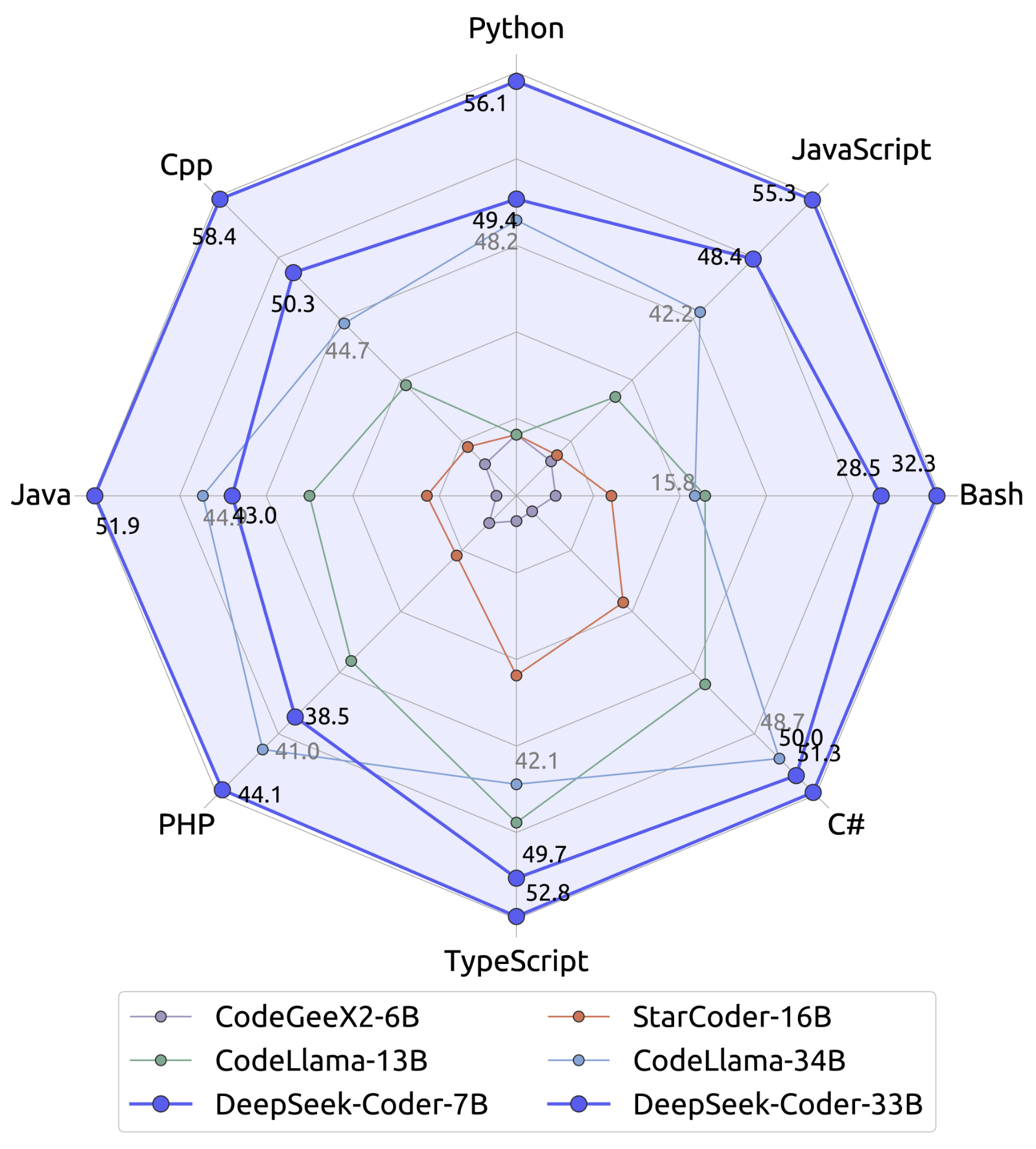
- Massive Training Data: Trained on a dataset comprising 87% code and 13% natural language, making it a highly capable tool for programming assistance.
- Highly Flexible & Scalable: Offered in model sizes of 1B, 5.7B, 6.7B, and 33B, enabling users to choose the setup most suitable for their requirements.
- Superior Model Performance: State-of-the-art performance among publicly available code models on HumanEval, MultiPL-E, MBPP, DS-1000, and APPS benchmarks.
- Advanced Code Completion Capabilities: A window size of 16K and a fill-in-the-blank task, supporting project-level code completion and infilling tasks.
DeepSeek LLM
A general-purpose Large Language Model (LLM) designed for a wide range of natural language processing (NLP) tasks. It comprises 67 billion parameters. It has been trained from scratch on a vast dataset of 2 trillion tokens in both English and Chinese.
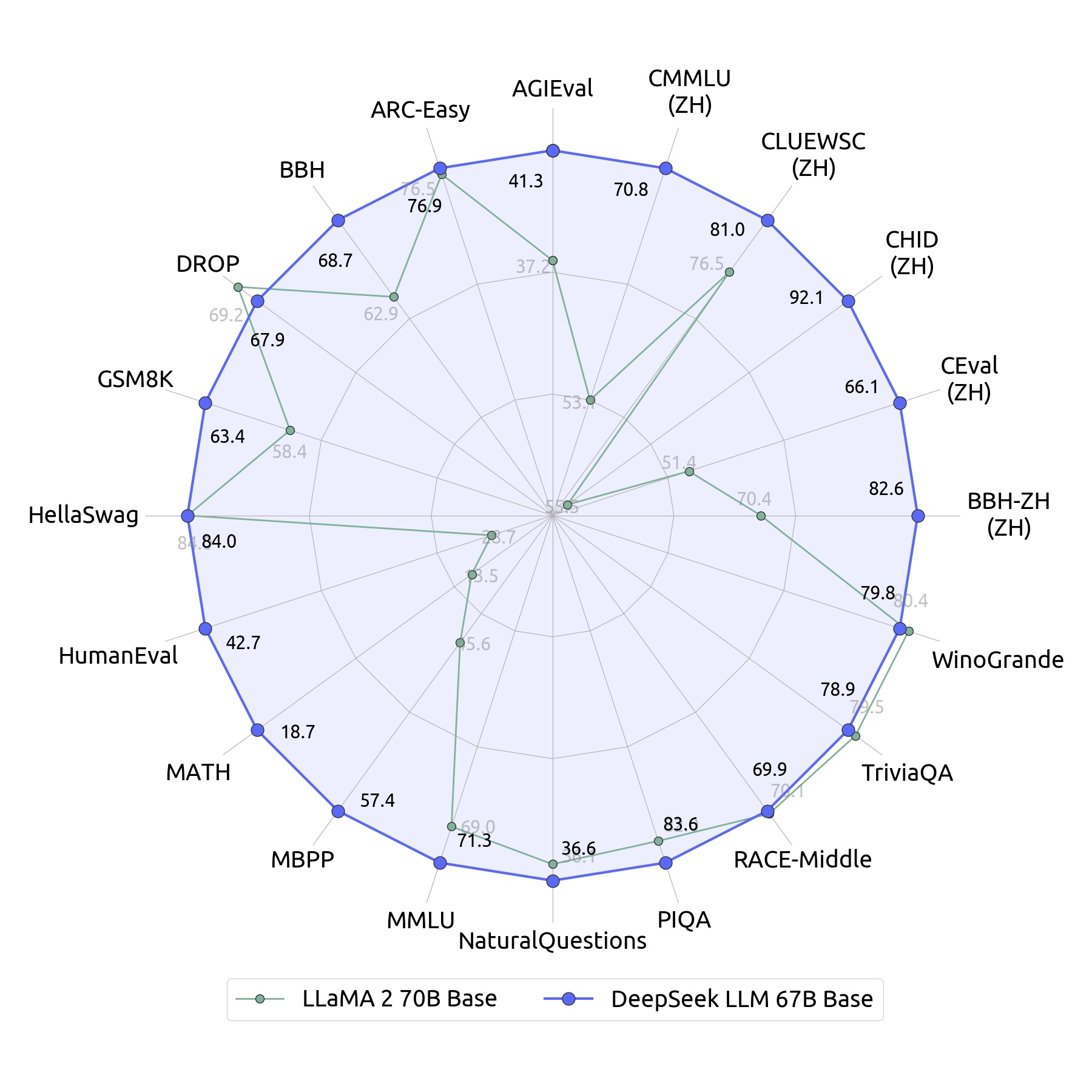
- Superior General Capabilities: DeepSeek LLM 67B Base outperforms Llama2 70B Base in areas such as reasoning, coding, math, and Chinese comprehension.
- Proficient in Coding and Math: DeepSeek LLM 67B Chat exhibits outstanding performance in coding (HumanEval Pass@1: 73.78) and mathematics (GSM8K 0-shot: 84.1, Math 0-shot: 32.6). It also demonstrates remarkable generalization abilities, as evidenced by its exceptional score of 65 on the Hungarian National High School Exam.
- Mastery in Chinese Language: Based on our evaluation, DeepSeek LLM 67B Chat surpasses GPT-3.5 in Chinese.
DeepSeek-V2
A more refined and efficient version of the original DeepSeek LLM, enhancing reasoning, coherence, and task adaptability.
Compared to DeepSeek 67B, DeepSeek-V2 offers better performance while being 42.5% cheaper to train, using 93.3% less KV cache, and generating responses up to 5.76 times faster.
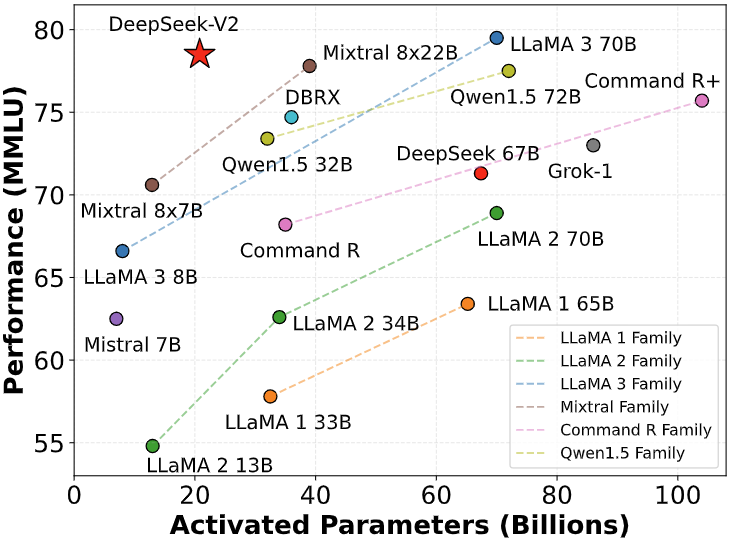
- Large-Scale Training: DeepSeek-V2 was trained on 8.1 trillion tokens from a diverse, high-quality dataset.
- Advanced Fine-Tuning: After pretraining, the model underwent Supervised Fine-Tuning (SFT) and Reinforcement Learning (RL) to enhance its capabilities.
- Proven Performance: Evaluation results show that DeepSeek-V2 performs exceptionally well on both standard benchmarks and open-ended generation tasks.
DeepSeek-Coder-V2
It is the upgraded version of the DeepSeek Coder, offering enhanced efficiency, accuracy, and multi-language support for developers.
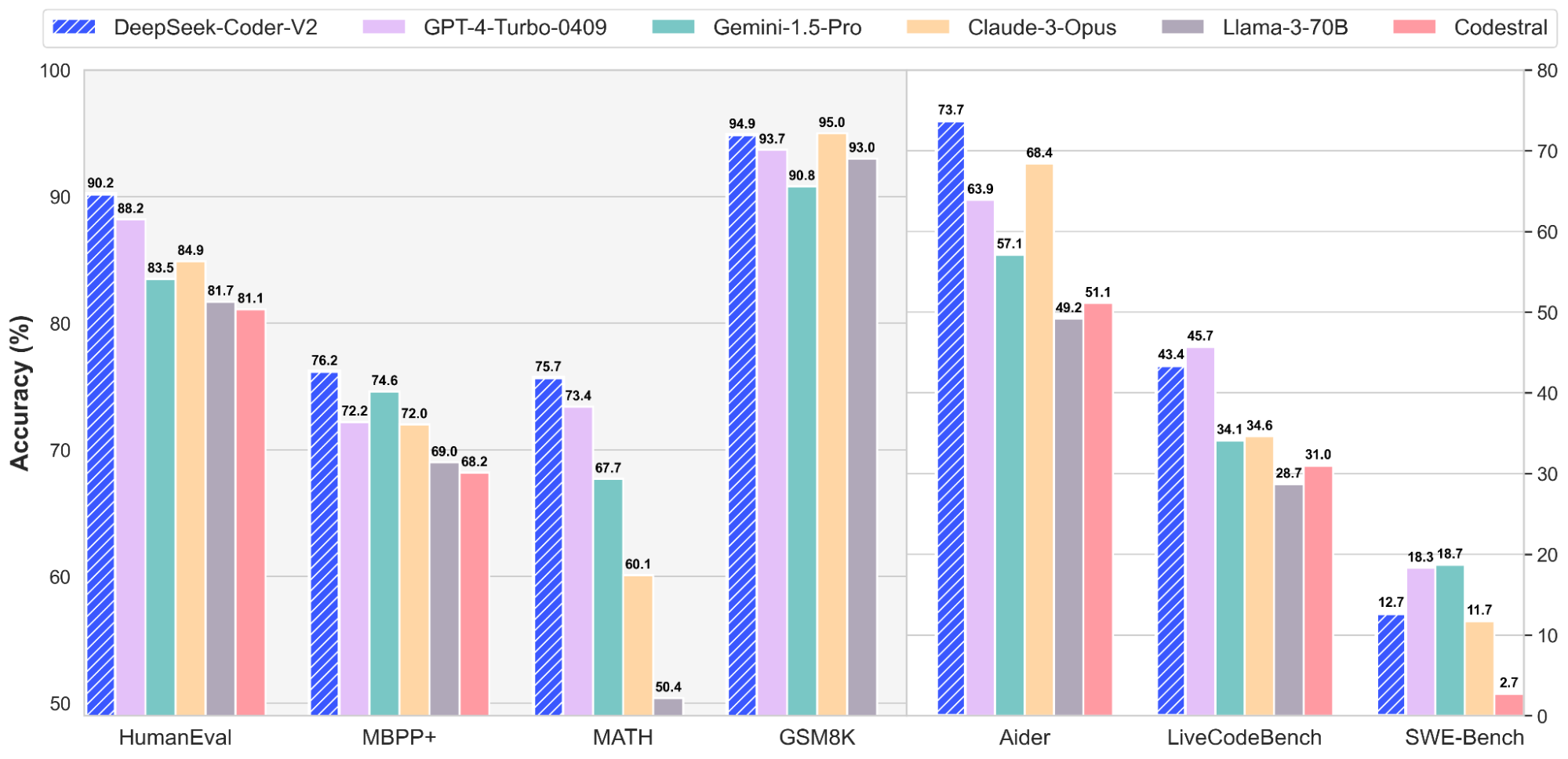
- Powerful Code Model: DeepSeek-Coder-V2 is an open-source Mixture-of-Experts (MoE) model designed for coding tasks, achieving performance comparable to GPT-4 Turbo.
- Improved Coding & Math Skills: The extended training significantly boosts coding and mathematical reasoning abilities while keeping strong general language performance.
- Major Advancements: Compared to DeepSeek-Coder-33B, it shows better performance in code-related tasks, reasoning, and overall capabilities.
- Expanded Language & Context Support: Now supports 338 programming languages (up from 86) and extends context length from 16K to 128K for handling larger code inputs.
DeepSeek-V3
A high-performance multimodal AI model that integrates text, images, and other data types to deliver comprehensive outputs.
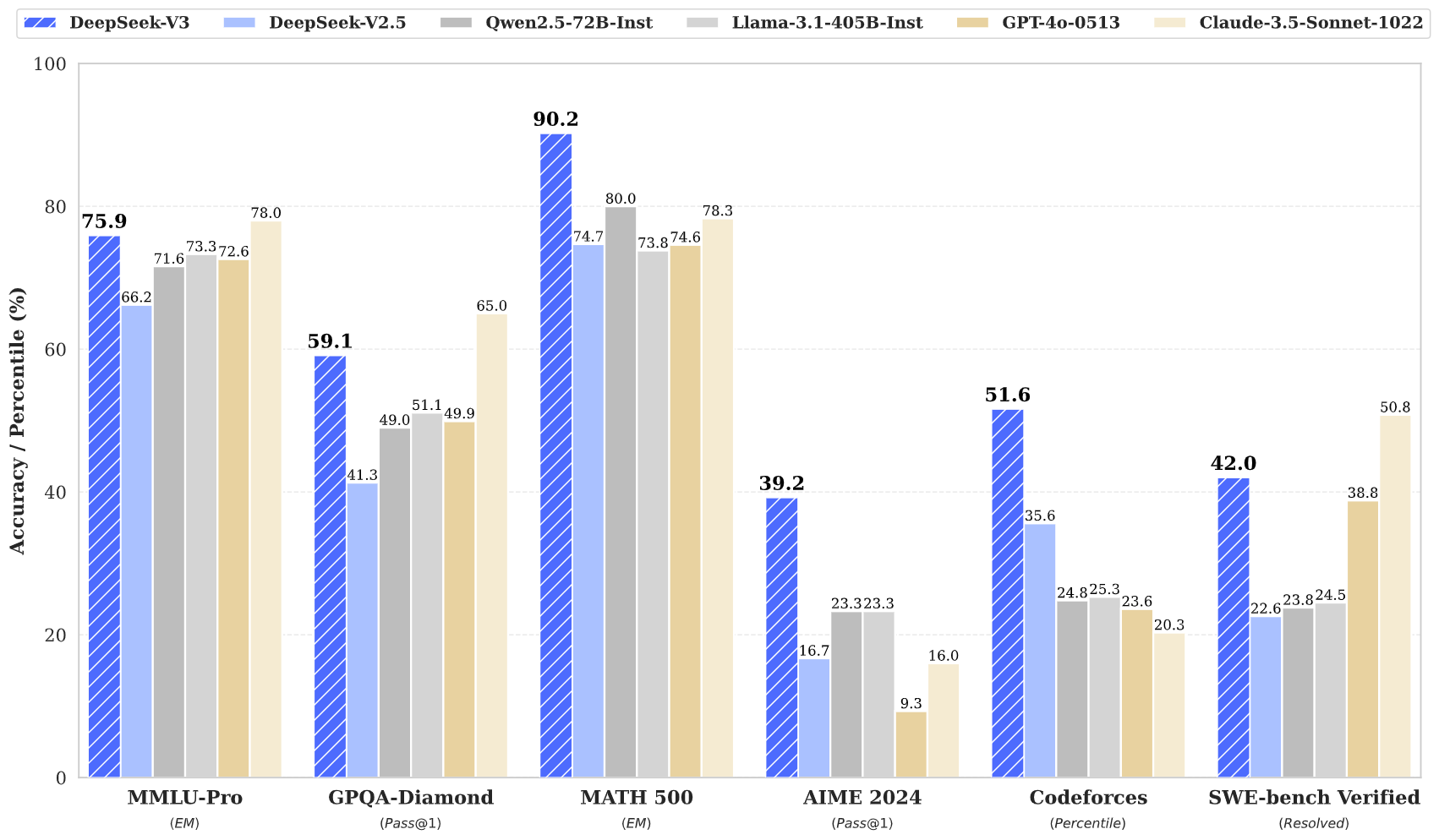
- Powerful & Efficient MoE Model: DeepSeek-V3 has 671B parameters (37B per token) and uses MLA & DeepSeekMoE architectures for faster inference and cost-effective training.
- Massive Pretraining & Fine-Tuning: Trained on 14.8 trillion tokens, followed by Supervised Fine-Tuning & Reinforcement Learning for top-tier performance.
- Competitive Performance: Outperforms open-source models and rivals leading closed-source AI models while requiring only 2.788M H800 GPU hours for training.
DeepSeek-R1
A research-focused AI model aimed at advancing machine learning capabilities with experimental techniques.
- Launched in January 2025: Built on DeepSeek-V3, designed for advanced reasoning tasks.
- Competitive Performance: Rivals OpenAI’s o1 model while being more cost-efficient.
- High Capacity Features: 671 billion parameters and a 128,000 context length for handling large inputs.
Janus-Pro-7B
A compact yet powerful 7-billion-parameter model optimized for efficient AI tasks without high computational requirements.
- It is Lightweight and cost-effective for smaller-scale AI applications.
- Fast inference speed with low latency.
- Retains strong text generation and coding abilities.
What are the Benefits of DeepSeek?
DeepSeek has quickly become a cornerstone for businesses and developers seeking cutting-edge AI solutions. Whether you’re automating workflows, generating code, or scaling operations.
DeepSeek offers unparalleled advantages that drive efficiency, cost savings, and reliability. Below, we explore the five core benefits of DeepSeek.
Turbocharged Efficiency & Productivity
AI-driven automation plays a crucial role in improving workflow efficiency. DeepSeek’s large language models (LLMs) process and generate text, code, and data-driven insights with high accuracy, significantly reducing manual effort.
For example, specialized models for developers can assist in code generation and debugging, cutting development time by up to 40%.
Beyond programming, DeepSeek’s natural language processing (NLP) capabilities enable faster document summarization, email drafting, and knowledge retrieval. These improvements free up time for higher-value tasks, enhancing overall efficiency.
Cost Savings You Can Measure
AI adoption is often limited by high costs, but DeepSeek changes that. DeepSeek R1 delivers performance comparable to OpenAI’s O1 at a fraction of the cost—$6 million to develop versus O1’s estimated $500 million. For everyday use, DeepSeek is also far more affordable:
- Input tokens: $0.55 per 1M tokens (vs. O1’s $15.00)
- Output tokens: $2.19 per 1M tokens (vs. O1’s $60.00)
This means DeepSeek is almost 27 times cheaper than Chatgpt’s O1 model, while still delivering powerful AI capabilities.
Enterprise-Grade Scalability
As businesses grow, their AI needs become more complex. DeepSeek is designed to scale across different environments, making it suitable for both small teams and large enterprises. According to Gartner, 80% of enterprises are expected to integrate AI-driven automation into their operations by 2026. DeepSeek’s modular architecture allows organizations to expand their AI initiatives without performance degradation.
Its cloud-native design ensures flexibility, supporting deployments in on-premise, hybrid, or cloud environments. This adaptability makes it a useful tool for applications ranging from customer service automation to large-scale data analysis.
Precision You Can Trust
AI accuracy is critical for applications requiring reliable outputs, such as financial modeling, legal document processing, and medical research. DeepSeek is trained on diverse datasets, allowing it to understand the context better and generate precise responses. Stanford AI Index Report shows that LLMs with well-structured training pipelines achieve over 90% accuracy in domain-specific tasks.
This high level of precision reduces errors in AI-generated content, improving the reliability of decision-making processes across industries. Whether used for content generation, customer support, or code development, accurate AI models help maintain quality and consistency.
Fort Knox-Level Security
As AI adoption grows, so do concerns about data security. The IBM Cost of a Data Breach Report states that the global average cost of a data breach reached $4.45 million, highlighting the need for robust security measures. DeepSeek incorporates encryption protocols and privacy-preserving techniques to safeguard sensitive information.
By ensuring compliance with security standards and minimizing data exposure, DeepSeek helps organizations mitigate risks related to unauthorized access and data breaches. These security measures are particularly important in sectors handling sensitive data, such as healthcare, finance, and legal services.
DeepSeek Use Cases and Examples
DeepSeek’s advanced AI capabilities make it a versatile tool across various domains. Let’s see the use cases of DeepSeek below:
Individual Uses
Personal Productivity
Deepseek can be your ultimate personal assistant, helping you stay organized and efficient in everyday tasks:
- Writing Assistance: Whether you’re drafting an essay, composing professional emails, or preparing detailed reports, Deepseek can help refine your writing and ensure clarity.
- Summarizing Long Documents or Articles: Save time by letting Deepseek condense lengthy documents into concise summaries, making it easier to grasp key points.
- Language Translation and Learning: Break language barriers by using Deepseek for real-time translation or as a tool to learn new languages through interactive explanations.
Creative Writing
For writers and creatives, Deepseek serves as a source of inspiration and refinement:
- Generating Stories, Poems, and Scripts: Struggling with writer’s block? Deepseek can generate creative content, from short stories to poetic verses, sparking your imagination.
- Brainstorming Ideas for Projects: Need fresh ideas for a project? Deepseek can provide innovative suggestions tailored to your needs.
- Editing and Proofreading Content: Ensure your work is polished and error-free by leveraging Deepseek’s editing capabilities to refine grammar, tone, and structure.
Business Uses
Customer Support & Automation
Businesses can leverage Deepseek to enhance customer experiences while reducing operational costs:
- Automating Responses to Common Queries: Use Deepseek-powered chatbots to handle FAQs, freeing up human agents for more complex issues.
- Providing 24/7 Chatbot Support: Offer round-the-clock assistance to customers, ensuring no query goes unanswered regardless of time zone.
- Handling Multi-Language Customer Interactions: Expand your global reach by enabling seamless communication in multiple languages.
Data Analysis and Insights
Deepseek excels at turning raw data into actionable insights:
- Analyzing Customer Feedback or Surveys: Quickly process qualitative feedback to identify trends, pain points, and areas for improvement.
- Generating Reports from Raw Data: Automate the creation of comprehensive reports, saving hours of manual effort.
- Identifying Trends and Patterns in Datasets: Uncover hidden opportunities or risks by analyzing large datasets for meaningful patterns.
Software Development
For developers, Deepseek acts as a coding companion that accelerates workflows:
- Assisting Developers with Code Generation and Optimization: Generate clean, efficient code snippets or optimize existing ones for better performance.
- Automating Repetitive Coding Tasks: Streamline mundane tasks like debugging, testing, or formatting code.
- Providing Technical Documentation and Troubleshooting: Access clear explanations of complex technical concepts or troubleshoot errors effectively.
General Use Cases
Research and Knowledge Discovery
Deepseek is a valuable ally for researchers and knowledge seekers:
- Summarizing Research Papers or Articles: Extract key findings from dense academic papers or articles without reading them in full.
- Finding Relevant Information Quickly: Search vast repositories of information to find exactly what you need in seconds.
- Exploring New Topics or Industries: Dive into unfamiliar subjects with confidence, as Deepseek breaks down complex topics into digestible insights.
Multi-Modal Applications
Deepseek’s ability to process both text and images opens up exciting possibilities:
- Combining Text and Image Analysis: Describe images accurately or analyze visual content alongside textual context.
- Generating Captions or Tags for Visuals: Automatically create captions or metadata for images, enhancing searchability and accessibility.
- Enhancing Accessibility for Visually Impaired Users: Convert visual content into descriptive text, empowering users with visual impairments to engage with multimedia content.
Industry-Specific Use Cases
Banking, Financial Services, and Insurance (BFSI)
In the BFSI sector, precision and efficiency are paramount—and Deepseek delivers:
- Generating Financial Reports or Forecasts: Automate the preparation of financial statements or predictive models based on historical data.
- Answering Customer Queries About Banking Products: Provide instant answers to questions about loans, credit cards, or investment options.
- Detecting Fraud or Anomalies in Transactions: Analyze transaction patterns to flag suspicious activities and prevent fraudulent behavior.
E-commerce
For e-commerce businesses, Deepseek enhances customer engagement and operational efficiency:
- Personalizing Product Recommendations: Deliver tailored product suggestions based on user preferences and browsing history.
- Automating Order Tracking and Updates: Keep customers informed about their orders with automated updates and notifications.
- Generating Dynamic Pricing Strategies: Optimize pricing dynamically based on demand, competition, and other factors to maximize revenue.
Telecom
The telecom industry benefits from Deepseek’s ability to streamline operations and improve customer satisfaction:
- Resolving Network Issues: Diagnose and address network-related problems faster by analyzing logs and providing troubleshooting steps.
- Managing Customer Complaints: Handle billing disputes, service interruptions, and other complaints efficiently through automated systems.
- Optimizing Resource Allocation: Predict peak usage times and allocate resources accordingly to ensure smooth operations.
Learn more: DeepSeek uses cases for businesses
What are the Limitations of DeepSeek?
There are some shortcomings that you should know about DeepSeek R1. Let’s discuss them below:
- The first thing is whenever you query something or whenever you give it some personal data, especially on the chat feature that data is going to be stored in the People’s Republic of China. This is not seen as a safe place to store all of your data.
- Then, it’s not ideal for creative work. Because it’s a reasoning model, it is best with logic, math, science, or coding questions. And that is what it optimizes over.
- And, one last limitation of DeepSeek R1 is that it has too much censorship. For example, if you ask it questions about China or the government, it will censor that information.
What are the Ethical Concerns Associated with DeepSeek?
As with any powerful AI technology, the use of DeepSeek comes with ethical considerations that need to be addressed to ensure responsible application. Below are some of the primary ethical concerns associated with DeepSeek:
Plagiarism and Deceitful Use
You must avoid using DeepSeek-generated content without proper attribution to prevent plagiarism. Always credit original sources when applicable.
Best Practice: Ensure proper attribution and transparency when using AI-generated content in publications, research, or other professional settings.
Bias in Training Data
DeepSeek, like other AI models, is only as unbiased as the data it has been trained on. Despite ongoing efforts to reduce biases, there are always risks that certain inherent biases in training data can manifest in the AI’s outputs.
Best Practice: Regularly audit the training datasets for biases and apply corrective measures to enhance fairness. You should also be aware of potential biases in AI-generated outputs and take them into consideration before use.
Privacy Issues
AI systems like DeepSeek may handle sensitive user data during interactions. This raises concerns about privacy, particularly when users provide personal, financial, or confidential information. Without adequate safeguards, this data could be at risk, whether from breaches or misuse.
Best Practice: Always review and comply with the platform’s privacy policies and terms of service. Ensure that strong data protection measures, including encryption and secure access protocols, are in place when using AI tools for sensitive applications.
How to Use DeepSeek? Step-by-step Guide
To use DeepSeek follow the below step-by-step guide:
For End-users
Step 1: Create an Account: Visit DeepSeek’s official website and click “Start Now.”
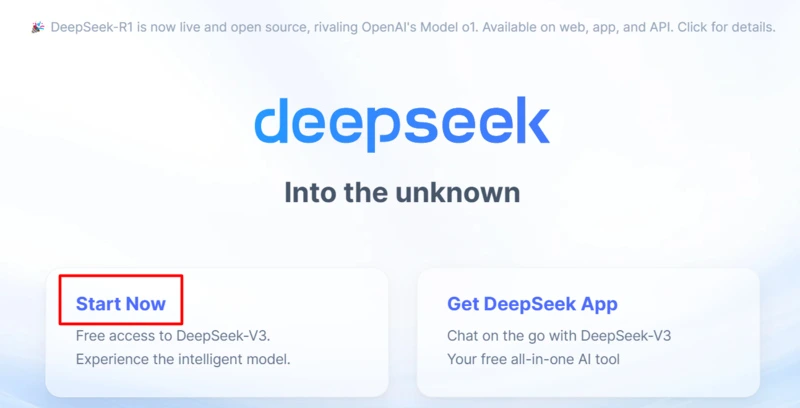
Step 2: Use your credentials to access the dashboard.
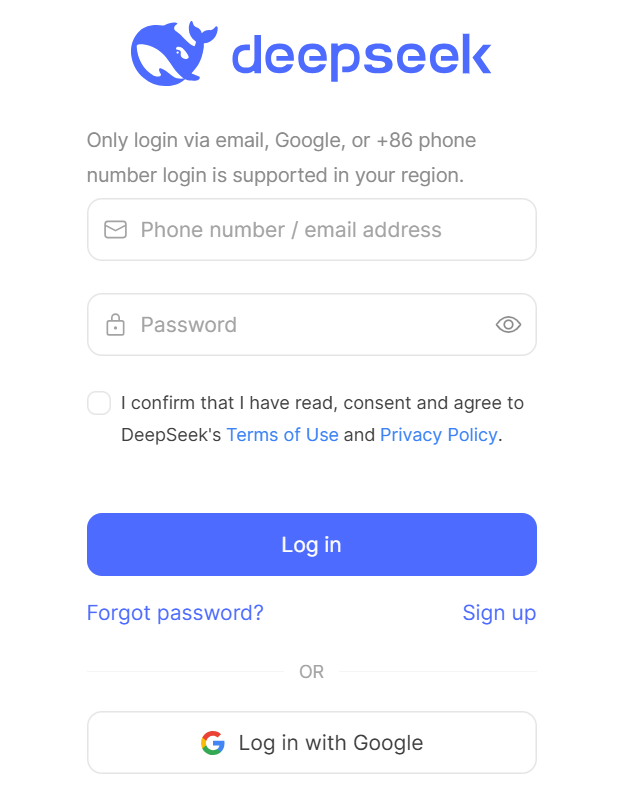
Step 3: After giving your credentials, you will get access to deepseek.
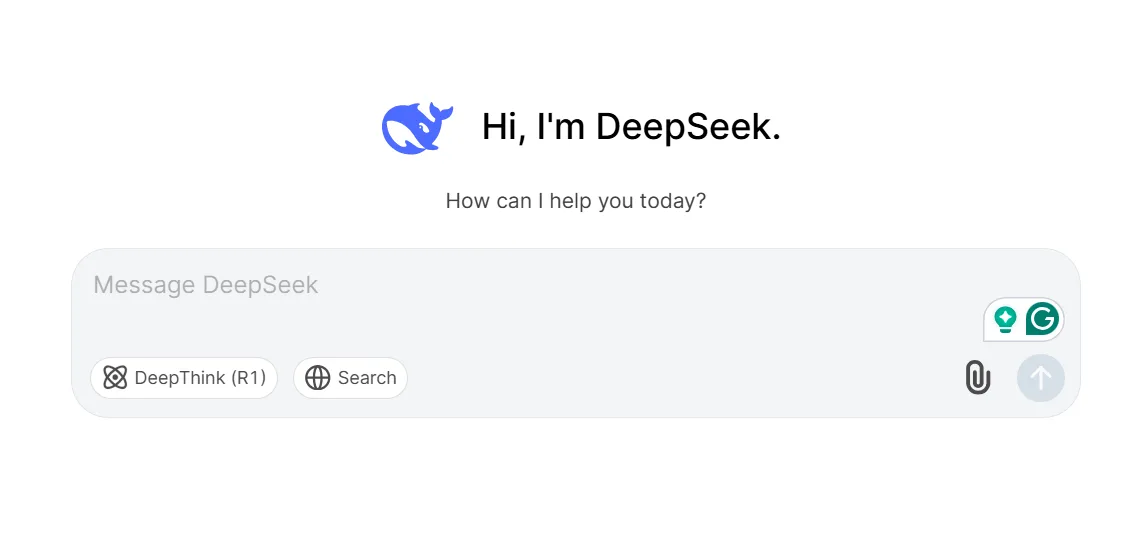
For Businesses
Step 1: Choose a plan (Free Tier for testing, Pro/Enterprise for advanced features).
Step 2: Verify Your Email: Check your inbox for a confirmation link.
Step 3: Login: Use your credentials to access the dashboard.
Pro Tip: Bookmark the login page for quick access.
After logging in follow the below steps to make it work for your business.
Set Up Your Environment
Generate an API Key
- Navigate to Settings > API Keys and click “Create New Key.”
- Securely store this key (it won’t be shown again).
Install SDKs/Libraries
You can copy this code: bash
pip install deepseek-sdk # Python example
Integrate with Tools
- Connect DeepSeek to platforms like GitHub, Slack, or Salesforce via pre-built plugins.
Choose the Right Model
DeepSeek offers specialized models for different tasks:
- DeepSeek-Coder: Code generation & debugging.
- DeepSeek-V3: General data analysis.
- DeepSeek-R1: Real-time IoT/robotics.
Example:
You can copy this code: Python
from deepseek import DeepSeekCoder
model = DeepSeekCoder(api_key=”YOUR_KEY”)
response = model.generate_code(task=”Build a Python web scraper”)
Input Data or Queries
Upload Data:
- Use CSV, JSON, or text files via the dashboard.
For APIs, structure your payload:
You can copy this code: json
{
“task”: “Predict sales Q4”,
“data”: “sales_2023.csv”
}
Write Clear Prompts:
- Bad example: “Analyze data.”
- Good example: “Analyze sales_2023.csv to forecast Q4 revenue with a 95% confidence interval.”
Process & Interpret Results
Run the Model: Click “Process” in the dashboard or trigger via API.
Review Outputs
- Dashboards: Visualize trends in graphs or heatmaps.
- Code/Reports: Download generated scripts or PDFs.
Iterate: Adjust parameters (e.g., temperature, max tokens) for refined results.
Example Output:
You can copy this code: python
# DeepSeek-Coder generated code
import requests
from bs4 import BeautifulSoup
def scrape_website(url):
response = requests.get(url)
soup = BeautifulSoup(response.text, ‘html.parser’)
return soup.title.text
Optimize & Automate
- Schedule Tasks: Set up recurring analyses (e.g., daily sales reports).
- Use Webhooks: Get real-time alerts for anomalies (e.g., fraud detection).
- Fine-Tune Models: Retrain DeepSeek on your data for niche tasks.
Ensure Security & Compliance
- Encrypt Sensitive Data: Enable AES-256 encryption in Settings > Security.
- Audit Logs: Track user activity under Settings > Audit.
- Compliance Checks: Ensure workflows meet GDPR/HIPAA standards.
Conclusion
DeepSeek represents a new era of open-source AI innovation, combining powerful reasoning, adaptability, and efficiency. From natural language processing (NLP) to advanced code generation, DeepSeek’s suite of models proves its versatility across industries.
As AI continues to reshape industries, DeepSeek stands as a formidable alternative to proprietary models, offering transparency, flexibility, and cutting-edge performance. Its rapid advancements signal a future where AI is more open, efficient, and tailored to real-world applications.
The question is no longer what is DeepSeek?—but rather, how will you leverage it to shape the future?
Frequently Asked Questions
Deepseek is generally considered safe for use, with robust security measures in place to protect user data and interactions. However, DeepSeek has raised security and privacy concerns, particularly regarding data collection and adherence to Chinese government censorship policies.
Deepseek offers competitive performance, particularly in reasoning like coding, mathematics, and specialized tasks. Also, it is an open source which makes it more effective than ChatGpt.
Deepseek is used for various AI applications, including natural language processing, code generation, customer support, content creation, and business automation.
Yes, DeepSeek’s algorithms, models, and training details are open-source, allowing others to use, view, and modify their code.
DeepSeek offers a cost-effective AI solution for businesses, providing tools for coding assistance, content creation, and data analysis. Its open-source nature allows for customization to meet specific business needs.
DeepSeek has gained popularity due to its comparable performance to leading AI models at a fraction of the development cost. Its open-source approach and accessibility have also contributed to its widespread adoption.
Yes, DeepSeek offers free access to its AI assistant, with applications available for various platforms.
DeepSeek was founded by Liang Wenfeng in 2023. He also serves as the company’s CEO.
Yes, DeepSeek collects user data, including chat and search query history, device information, and other personal details. This data is stored on servers located in China, raising concerns about potential access by the Chinese government



